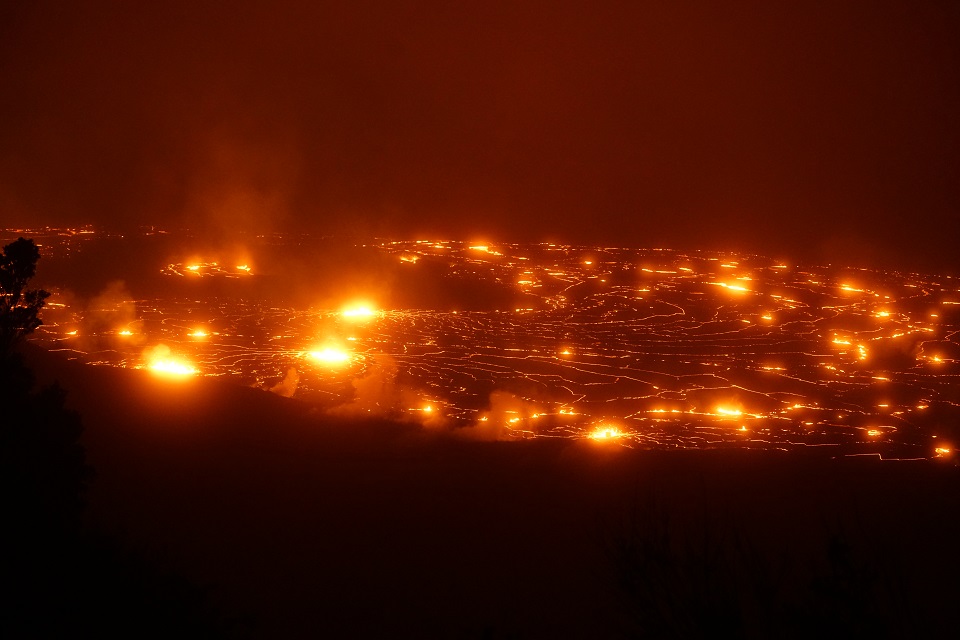News Release

NPS Photo/M.Newman
|
Subscribe
|
Contact: Jody Anastasio, 808-985-6020
HAWAII NATIONAL PARK, Hawaiʻi – A new eruption at the summit of Kīlauea volcano is drawing thousands of visitors to Hawaiʻi Volcanoes National Park eager to see new erupting lava by day and the lava glow after dark. This new eruption is viewable from almost all open areas around the caldera.While the park remains open 24 hours a day, Puʻupuaʻi Overlook and parking lot are closed to protect breeding and nesting nēnē. The overlook west of the Uēkahuna parking lot also remains closed to protect nēnē. The restrooms, parking lot and viewing areas to the east remain open.
The public is reminded to stay safe and help protect park resources by following these precautions:
- Volcanic eruptions can be hazardous and change at any time. Stay on marked trails and overlooks, and avoid earth cracks and cliff edges. Do not enter closed areas.
- Hazardous volcanic gases are billowing out the crater and present a danger to everyone, especially people with heart or respiratory problems, infants, young children and pregnant women. Check the park air alert web page before and during your visit.
- Slow down and drive safely. Expect long waits for parking spaces at popular vantage points like Uēkahuna (formerly the Jaggar Museum) and Devastation Trail parking area.
- Do your part to help protect nēnē by keeping your distance, at least four car lengths away, and never feed nēnē or wildlife. Handouts make nēnē seek out people and cars, putting them in great danger. Drivers should be alert for nēnē along park roads, always observe the speed limit, and slow down for all nēnē crossing signs in the park and throughout the island.
- At 1,219 meters, (4,000 feet), the summit of Kīlauea can be chilly at any time. Bring a rain jacket, wear long pants and closed-toe shoes. Bring a flashlight if visiting at night.
So what can visitors expect to see? It depends on when they arrive, and the weather.
In the Dark. A magnificent reddish orange glow fills the dark sky. Lava flows have covered much of Halemaʻumaʻu crater floor (which is nearly 300 acres or 120 hectares), reflecting into the gas plume wafting out of the volcano, and onto any clouds above. Jagged crater walls are illuminated, showing the scars from the 2018 summit collapse.
In Daylight. Volcanic gas and steam billow out of Halemaʻumaʻu, and the entire summit caldera, Kaluapele, is fully visible. Koaʻe kea, white-tailed tropicbirds, are often observed flying above the crater.
The best eruption viewpoints day or night are along Crater Rim Trail, and include Uēkahuna, Kīlauea Overlook, Wahinekapu (Steaming Bluff), Kūpinaʻi Pali (Waldron Ledge), Keanakākoʻi and other overlooks.
Eruption status updates, live web cams, closure notifications, and planning tips are available on the park website.
While an eruption is an exciting experience, keep in mind you are observing a sacred event. The summit of Kīlauea volcano is a wahi kapu (sacred landscape) surrounded with storied places and a fragile ecosystem.
About the National Park Service. More than 20,000 National Park Service employees care for America's 424 national parks and work with communities across the nation to help preserve local history and create close-to-home recreational opportunities. Learn more at www.nps.gov and on Facebook, Instagram, Twitter, and YouTube.
Last updated: January 6, 2023
